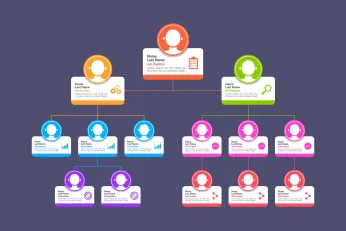Territory Planning: 6 Steps to Build a Sales Territory Plan with Best Practices
Territory planning is a process of dividing the potential customer base into distinct geographical or market segments for the sales force.
On this page
A report revealed that 81% of the sales team neglect to review or refine their processes. This alarming statistic, along with the fact that one in five sales teams lacks the necessary resources to optimize their workflow, shows a critical gap in sales strategy. A foundational element often overlooked in bridging this gap is the sales territory plan.
The territory planning divides the target market into manageable segments and allows the sales teams to operate efficiently to maximize revenue and deliver exceptional customer experiences. In fact, Bain & Co.’s research indicated a strong correlation between customer experience and financial performance.
It established that businesses that prioritize exceptional customer experiences often report a revenue increase of 4-8% compared to their counterparts. Therefore, this blog will explore the concept of sales territory planning, the process of constructing effective sales territories, and discuss strategies for gaining a competitive advantage.
What is sales territory planning?
To understand sales territory planning, it is essential to first learn the concept of a sales territory. A sales territory is a designated geographic or customer-based region assigned to an individual salesperson or sales team. This covers both existing and potential customers so that the sales force can concentrate their efforts within a defined market.
Sales territory planning, however, is the systematic process of dividing the potential customer base into distinct geographical or market segments. These segments are then allocated to specific sales representatives to optimize their performance strategically for maximum output.
If done well, the territory planning can lead the sales force to:
- Optimize its sales effort by having efficient market coverage.
- Deploy targeted sales strategies and improve sales productivity.
- Have a straight-forward account plan to enhance customer relationship management.
- Record accurate sales forecasting and performance measurement.
Let us go through a strategic study of why territory, the foundation of sales enablement, is significant.
→ 49.6% have shared that their primary focus of sales enablement within companies is on sales process improvements.
→ The same study revealed that sales coaching encompasses a variety of areas, including lead and opportunity management, sales funnel optimization, skill and behavioral development, and account and territory management.
→ Moreover, 82.8% of organizations have revealed that sales coaching has led to having an engaged sales force.
How does the sales territory plan take place?
The sales territory plan involves dividing the customer base into different specific groups. Then these groups would be assigned to different sales teams. The plan would be split into regions and factors like company size, industry, and product type are also important.
By assigning a sales team to this specific territory, the company can tailor its sales approach and resources to effectively address the unique needs of this customer segment.
The goal is to align the overall business objectives with the resources. So, to break the process even further, as per the respective industries:
- The first step requires one to do a region-wise split for sales territories.
- The sales team will be assigned to these territories, often accompanied by sales quotas.
- The market potential would be taken into account while doing territory planning.
- The next step would be to determine the regions with the highest historical demand and profitability because they may receive a larger sales force. Conversely, untapped markets with growth potential may warrant increased sales investment.
Once the sales manager is equipped with the analytical data, they can move forward to create the sales territory design.
So, to disseminate the sales forces accordingly to approach the right customers, what Manheim needed was to streamline their deployment decisions. Manheim evaluated their already existing sales process. It significantly coordinated the deployment decision and performance evaluation of the sales force.
In addition to this, the organization went beyond mere process management to optimize the facets of sales performance management, especially territory optimization, and noticed their sales went up. They recorded $57 billion in transactions of used vehicles.
How to do sales territory planning?
A study revealed that a buyer receives up to 140 emails every day but opens about 20% of those emails and clicks through to websites from just 2%. This showcases the significance of creating a thorough territory plan to target the right customer. To do sales territory planning, you must:
1. Analyse your target market
Define your target market by understanding your company's core values, goals, and most profitable customer segments. This involves dividing your customers into groups based on various factors such as location, industry, and purchase history. To split the target market region-wise, you need to analyze:
- Geographic location: Divide territories based on physical locations like cities, states, or countries.
- Market potential: Allocate territories based on the market size and potential sales opportunities.
- Customer segments: Group customers with similar needs or behaviors into the same territory.
- Sales volume: Consider current and projected sales volumes to ensure balanced workloads.
2. Conduct SWOT analysis
Assign your best sales reps to the highest potential territories based on their strengths and experience. The process typically commences with a thorough SWOT analysis to identify the organization's strengths, weaknesses, opportunities, and threats. This assessment provides valuable insights into the company's competitive position and market potential. SWOT analysis means:
- Strengths: Identify what your sales team excels at, such as strong customer relationships or a broad product range.
- Weaknesses: Recognize areas for improvement, such as limited resources or gaps in product knowledge.
- Opportunities: Look for external factors that could benefit your sales, like emerging markets or new product lines.
- Threats: Identify potential challenges, such as increased competition or market saturation.
3. Assess the territory and account
To optimize sales efforts, a granular understanding of account and territory quality is essential. Each account within the target market should be assessed based on factors such as revenue potential, growth prospects, competitive intensity, and customer lifetime value.
Quantitative metrics like purchase frequency, average order value, and profit margin can be coupled with qualitative assessments of customer relationship strength and strategic fit. Moreover, the overall health of a sales territory is determined by a combination of factors, such as:
- Sales cycle length that indicates the complexity of the sales process
- Churn rates that indicate the customer retention challenges
- Repeat purchases that indicate customer satisfaction and loyalty.
4. Analyze your cost according to analysis
To properly allocate the resources, you need to understand the financial output from your side. Go through the CAC for different territories to pinpoint regions with higher acquisition costs. This will help you indicate potential inefficiencies in sales and marketing efforts.
5. Evaluate your performance for continuous improvement
The sales landscape is dynamic which showcases the necessary ongoing monitoring and adaptation. Track key performance indicators, customer feedback, and market trends for timely adjustments to sales strategies and territory boundaries.
6. Strike a balance between new and existing business
Consistent lead generation is essential for long-term growth. So, implement lead nurturing programs and explore new market segments to expand the customer base. However, keep in mind that retaining existing ones is equally crucial. Building strong customer relationships, providing exceptional service, and offering value-added services can enhance customer loyalty and increase repeat business.
Sales efforts can be hindered when salespeople manage multiple tasks simultaneously. To maintain sales team motivation, sales performance management software, such as Compass, is necessary for efficient incentive distribution. Incentives serve as a motivational tool within sales territory planning.
By strategically using incentives, organizations can enhance sales performance by directing focus toward specific goals and fostering competition among sales representatives. Compass simplifies incentive distribution and provides real-time revenue insights. It also gives them visibility into trends forecasting and optimization of future goals and budgets. This empowers sales leaders to make informed decisions regarding territory and quota planning.
Case studies
We will examine two case studies that better capture the importance of sales territory planning.
1. US-based pharmaceutical company capture over 85% of the market potential with agile territory planning
A U.S.-based pharmaceutical company with an expanded 120 sales territories faced a high vacancy rate. They wanted to optimize the sales force structure while minimizing the disruption that takes place in the team. To understand which area needs to be optimized, they conducted thorough research.
The organization noted that they needed to streamline the segmentation and targeting method, accordingly, allocate territory to the proper sales force based on the analysis, and have an agile territory design in place. So, they got access to prescriber-level data from IQVIA to categorize prescribers based on market potential and market share.
Using this data, they understood what kind of model is needed to determine the sales force sizing. They went for a proprietary analytical model to gather the optimal call frequency for each prescriber segment. This analysis allowed the organization to get an estimate of the ideal sales force size required for complete U.S. coverage.
They further used the territory maps to assign ZIP codes and integrate them with existing territory boundaries and representative home locations. This led them to:
- Have a 90-territory structure.
- Capture over 85% of the market potential
- Have limited disruptions to sales representatives
- Maximized staff retention
- Eliminate vacant positions.
2. A US-based IT firm records 18% increase in sales productivity with proper territory planning
A US-based technology firm specializes in threat detection and response for enterprise businesses. This organization wanted to identify the sales inefficiencies that impact on the sales force's productivity and performance. The organization faced several obstacles. Their existing customer segmentation criteria were overly complex and subjective.
The company incurred high sales costs due to a layered organizational structure, with certain departments contributing to suboptimal results. Lastly, the organization consistently fell short of revenue goals. Insufficient sales personnel, delayed hiring, and onboarding difficulties contributed to lower overall productivity. Limited operational investments hampered the company's capacity to optimize compensation plans, sales territories, and quotas as well.
So, they needed to create an effective annual sales plan with clear, achievable goals and practical strategies. They revised their segmentation model with new objective criteria such as customer spending, company size, and revenue.
This approach aimed to prioritize enterprise accounts, reduce account workloads, and minimize coverage gaps. The resulting segmentation would classify accounts into Tier 1, Tier 2, and Tier 3 categories, with distinct subcategories for the Public Sector and Financial Services industries.
They also adjusted the organic sales representatives in Tier 2 markets to expand customer interaction time and consequently drive increased sales. An account-based model was recommended for Tier 1 accounts, a geography-based territory model for Tier 2, and a channel-led model for Tier 3.
This approach aligned sales investment with market segments. Sales compensation plans were to be refined for each role to simplify structures. Lastly, the customer success managers would transition to an at-risk compensation model to ensure their incentives are aligned with other customer-facing positions.
As a result, the annual sales plan with strong territory planning allowed the company to notice:
- 18% increase in sales productivity.
- A consistent sales expenditure.
- Increased representative participation along with balanced territories and quotas to optimize performance.
- An increase in new client acquisitions to contribute significantly to Annual Contract Value growth.
Sales territory best practices
Based on the two case studies, let us take key learning points that can be used as a best practice to create sales territory plan.
From the pharmaceutical company, we learned to:
- Streamline segmentation and targeting: The organization recognized the need to enhance its segmentation and targeting methods. This involved allocating territories to the appropriate sales force based on detailed analysis and implementing a flexible territory design.
- Utilize Data for Optimization: The company accessed prescriber-level data from IQVIA to categorize prescribers according to market potential and market share. This data helped determine the appropriate model for sizing the sales force.
- Have a data-backed sales force: The organization adopted a proprietary analytical model to establish the optimal call frequency for each prescriber segment. This analysis provided an estimate of the ideal sales force size required for comprehensive coverage across the United States.
From the IT company, we learned to:
- Simplify the customer segmentation: The firm's initial customer segmentation criteria were overly complex and subjective. By revising their segmentation model to include objective criteria such as customer spending, company size, and revenue, they were able to prioritize enterprise accounts effectively. This shift helped reduce account workloads and minimize coverage gaps, ultimately leading to improved sales performance.
- Structure the sales costs: The organization faced high sales costs due to a layered structure that contributed to suboptimal results. Streamlining this structure improved communication and collaboration among departments, and improved efficiency.
- Create strategic sales planning: Create an effective annual sales plan with clear, achievable goals and practical strategies. It was essential for the IT organization. The implementation of an account-based model for Tier 1 accounts, a geography-based territory model for Tier 2, and a channel-led model for Tier 3 allowed for better alignment of sales investment with market segments. This type of strategic planning is vital for optimizing sales efforts and ensuring that resources are allocated effectively.
- Include compensation and incentives: The need to refine sales compensation plans for each role was identified as a way to simplify structures and motivate sales personnel. You can do it using an incentive management service like Compass. With such a service, you will be opening an opportunity for the sales force to have a cohesive approach to customer engagement and satisfaction.
Conclusion
Territory planning is a critical component of sales strategy that involves dividing a geographical area into distinct regions for sales representatives to manage. This process is essential for optimizing sales performance, which can be improved with sales incentives. Not only will it increase engagement level but boost sales representatives' performance. To do so, we recommend using Compass, a sales incentive automation platform. With Compass, you can:
- Get a unified view of the sales team performance metrics, target vs attainment data, and more on a single platform.
- Monitor the performance of multiple channel sales teams in real time and optimize targets accordingly.
- Handle quota structures of any complexity. It has a customizable quota module that can manage splits, differences, and multiple quotas seamlessly for every sales rep.
Integrate Compass easily with ERP, CRM, and HRMS. Schedule a demo with our specialists to learn how our service can be the answer to your problem.













